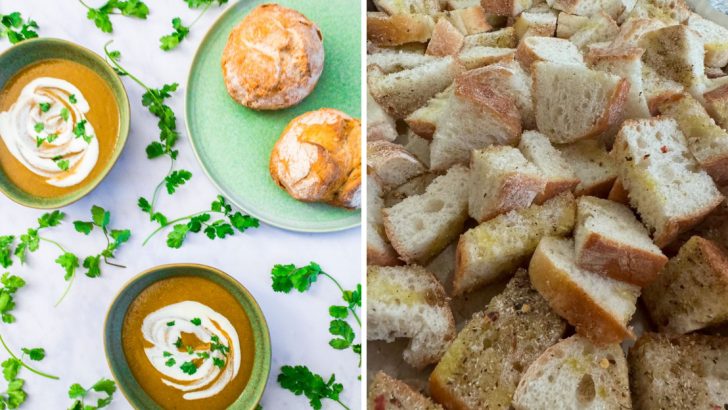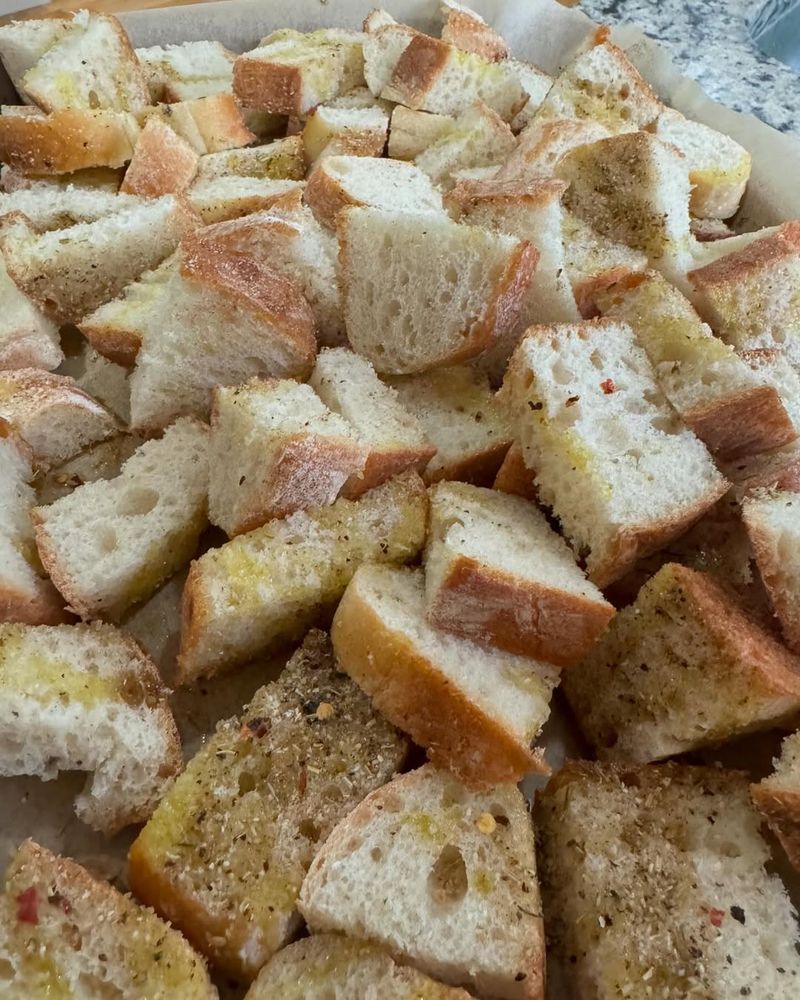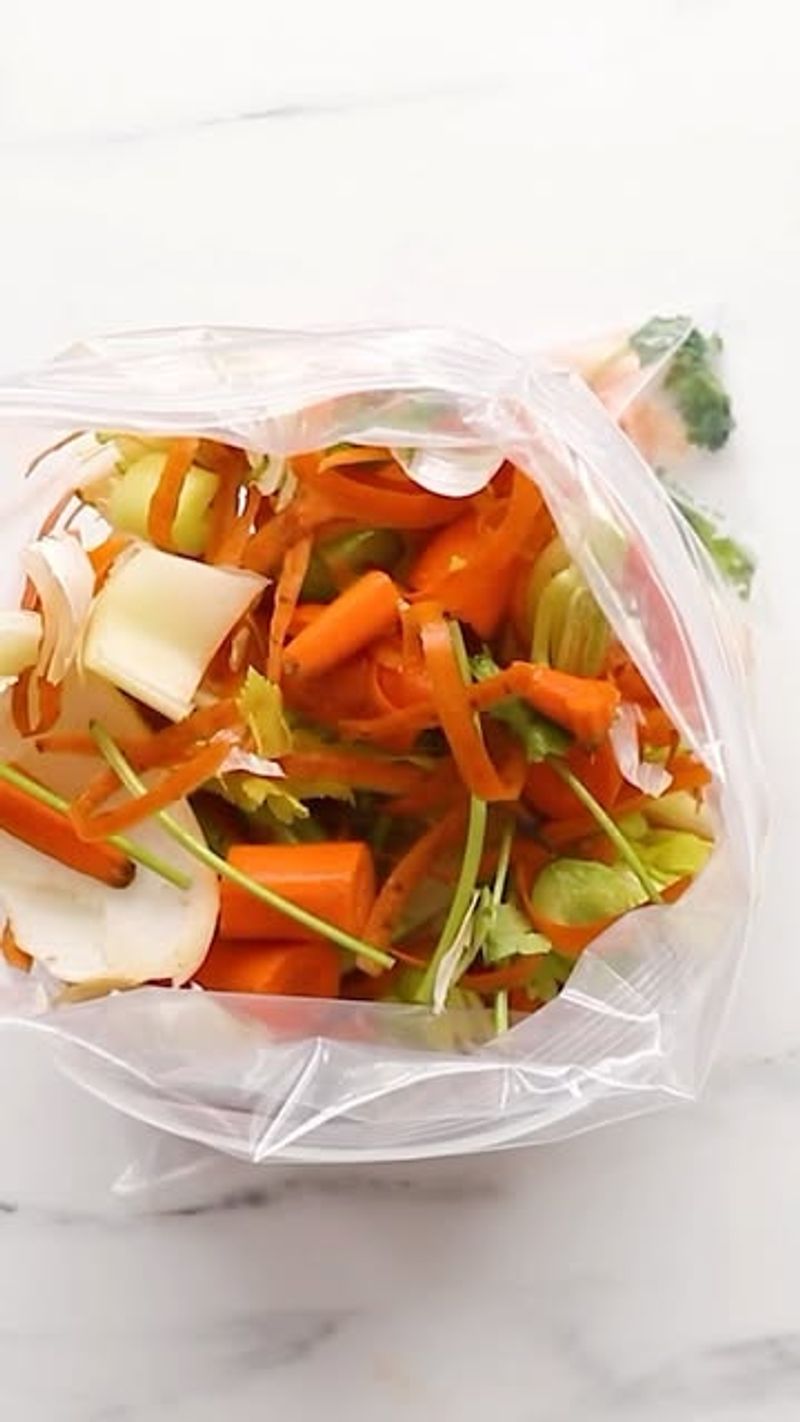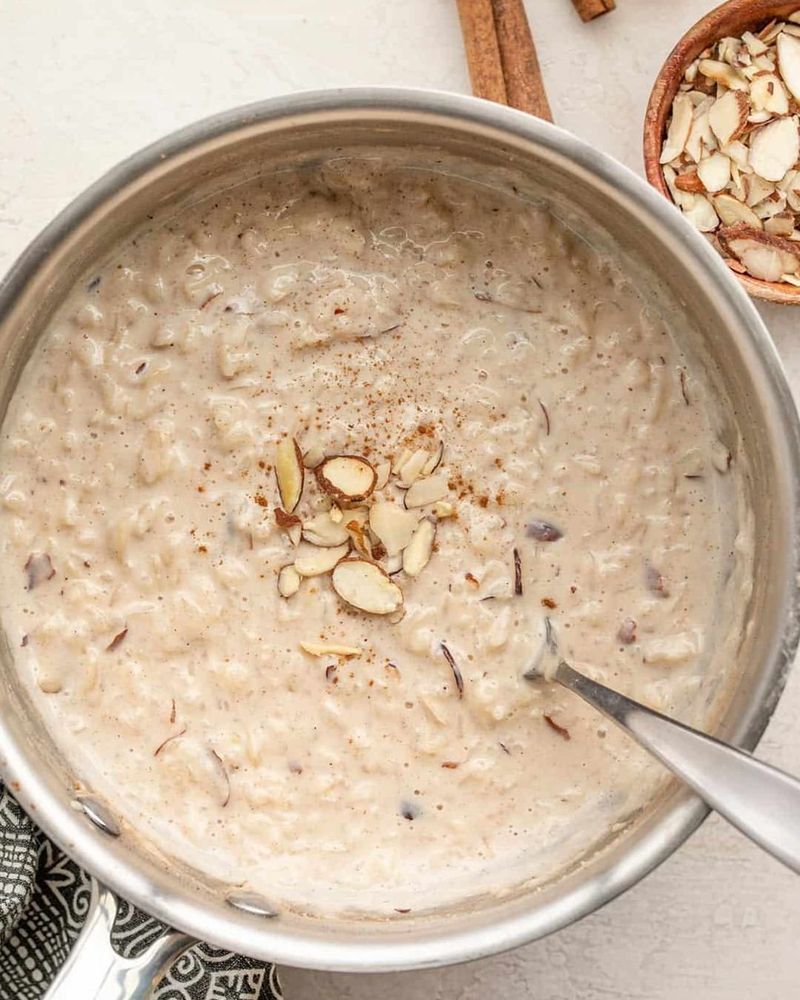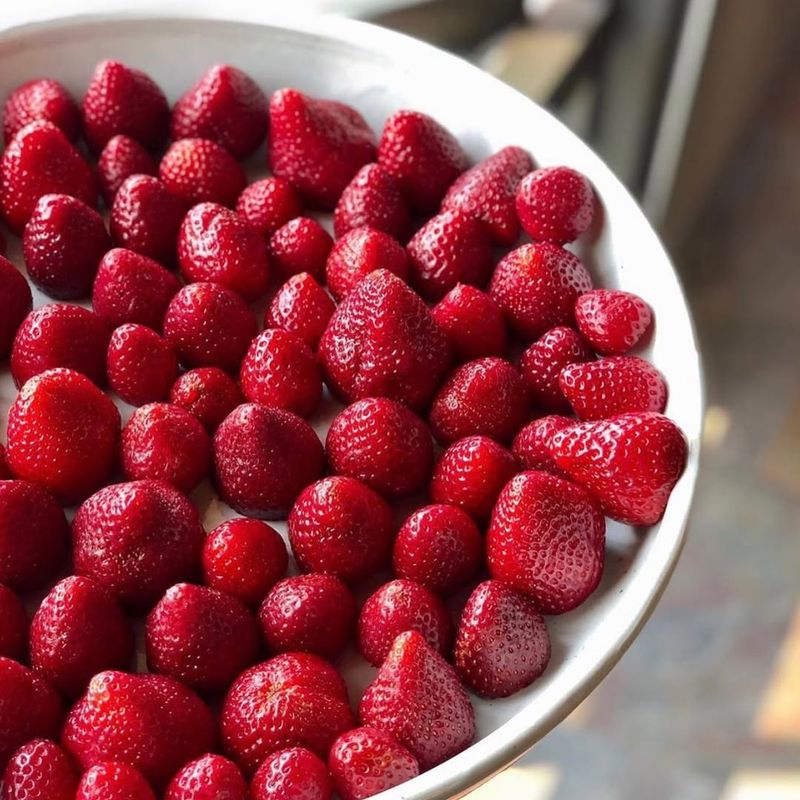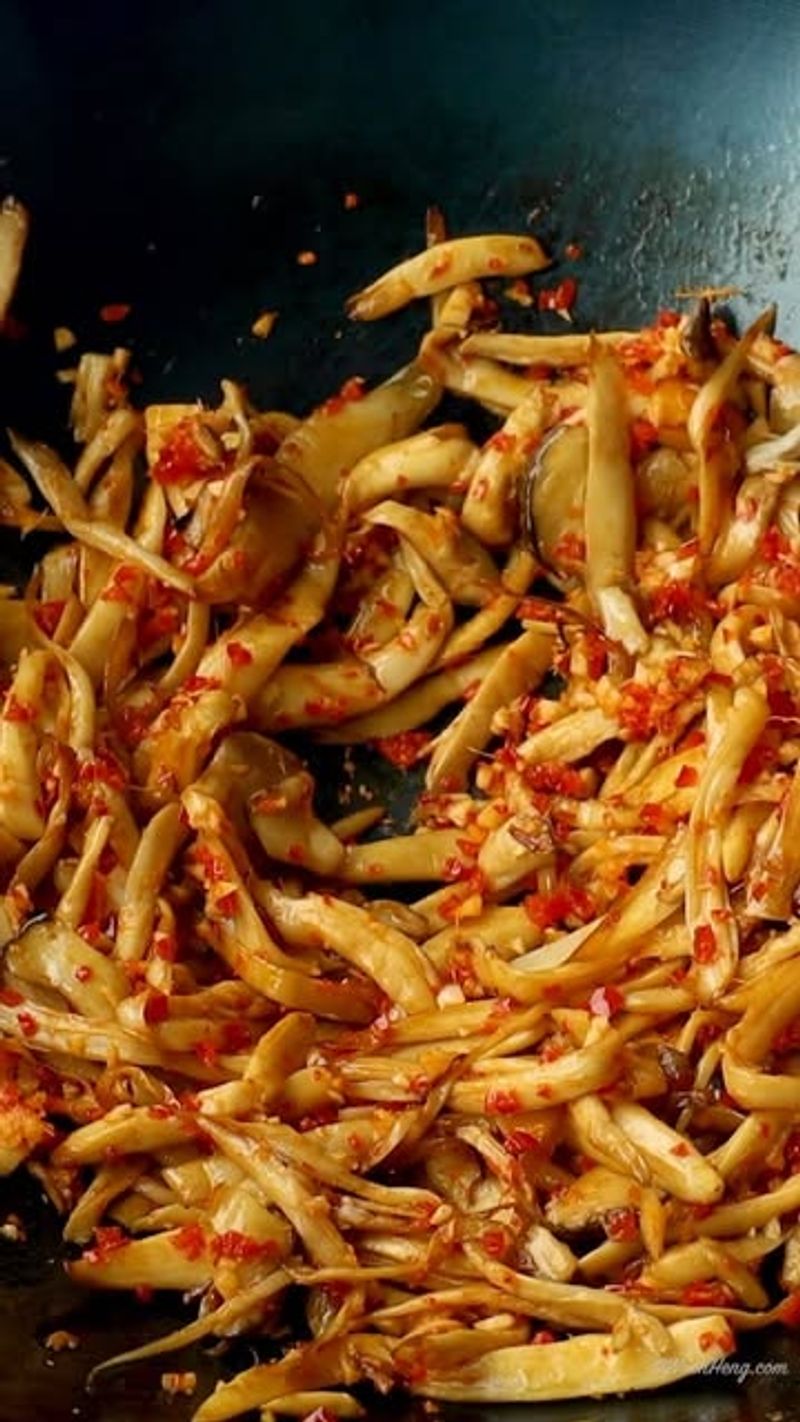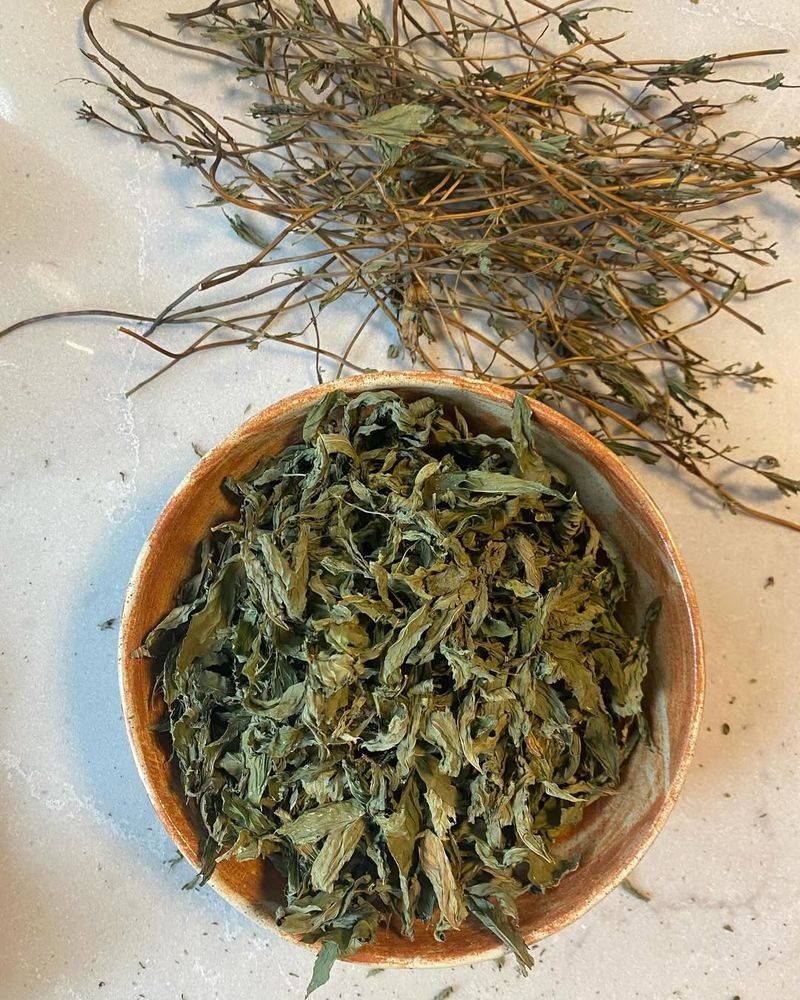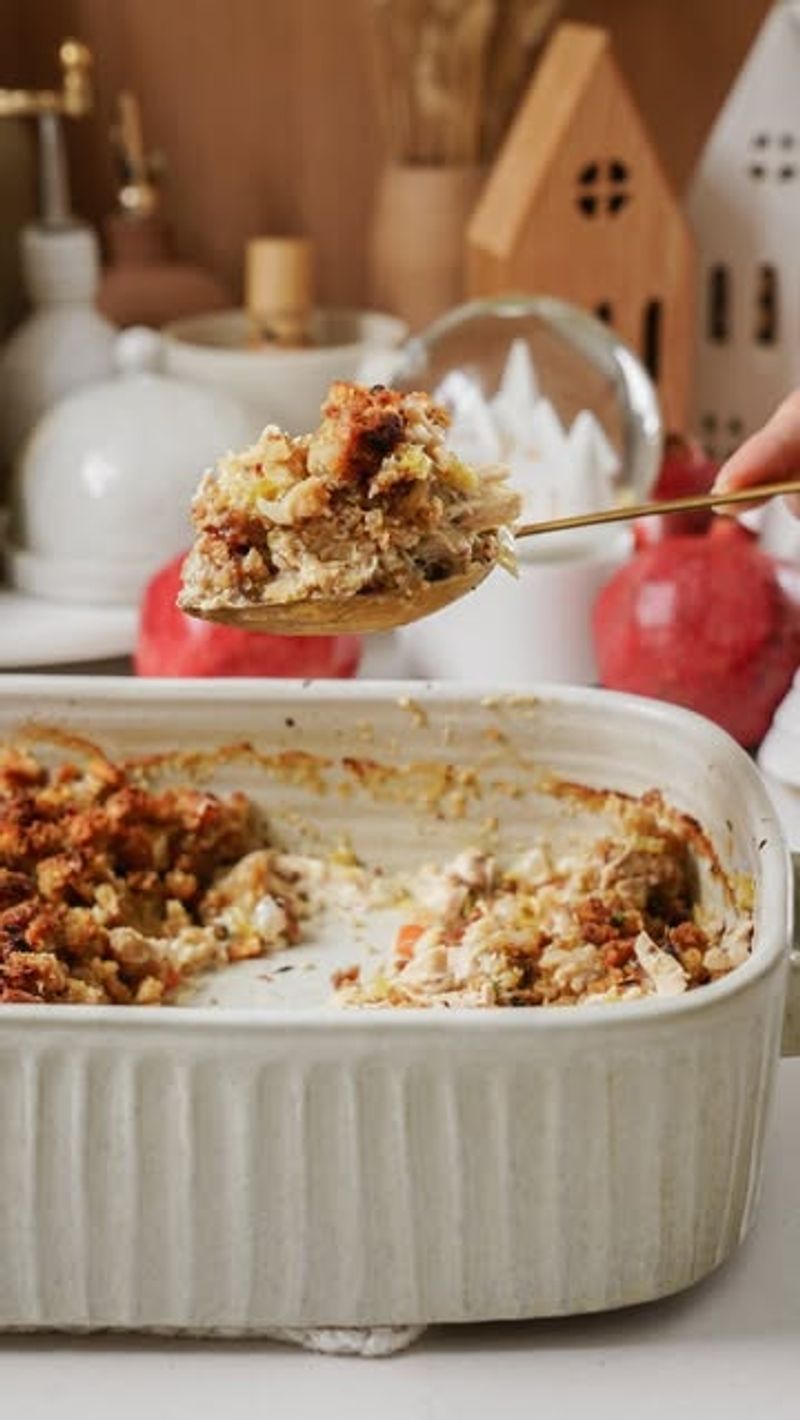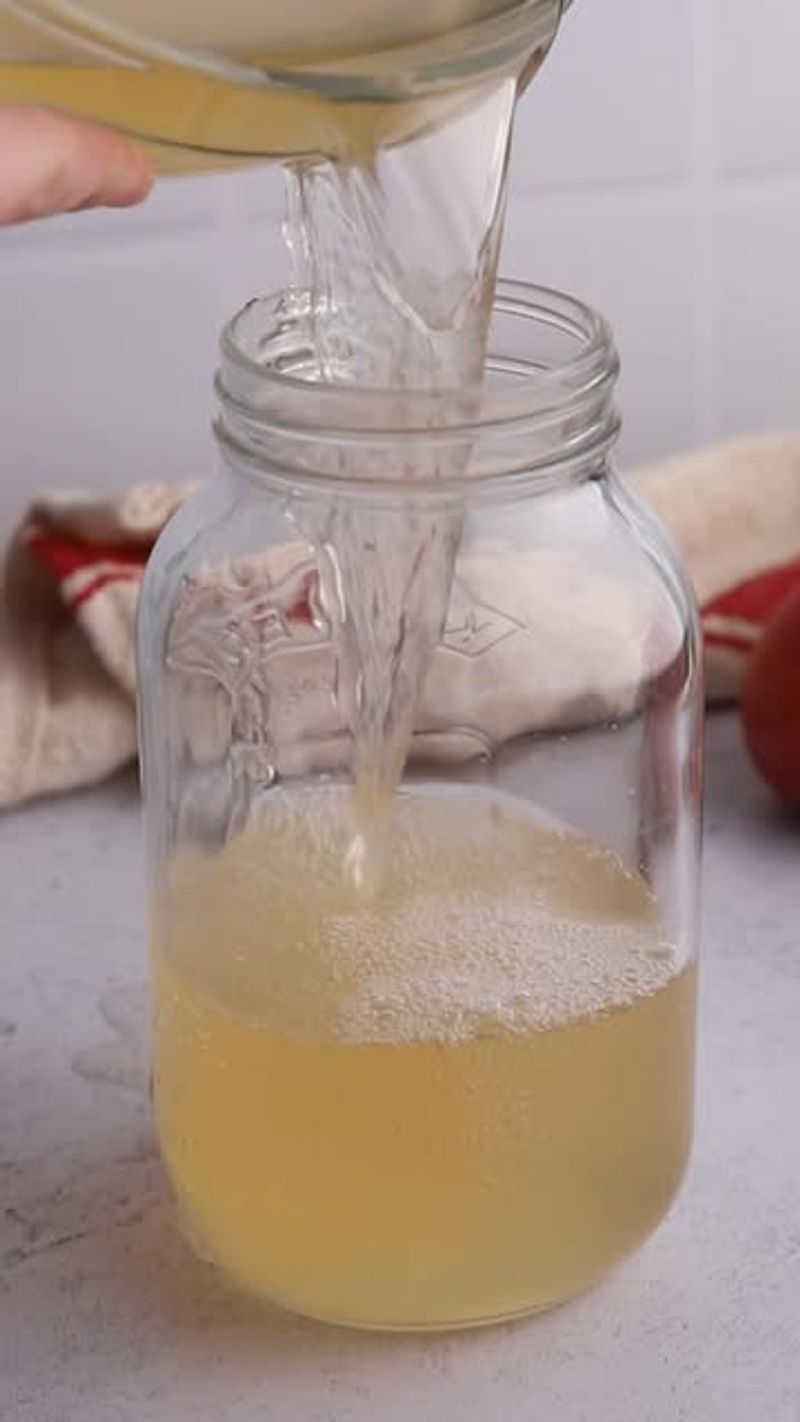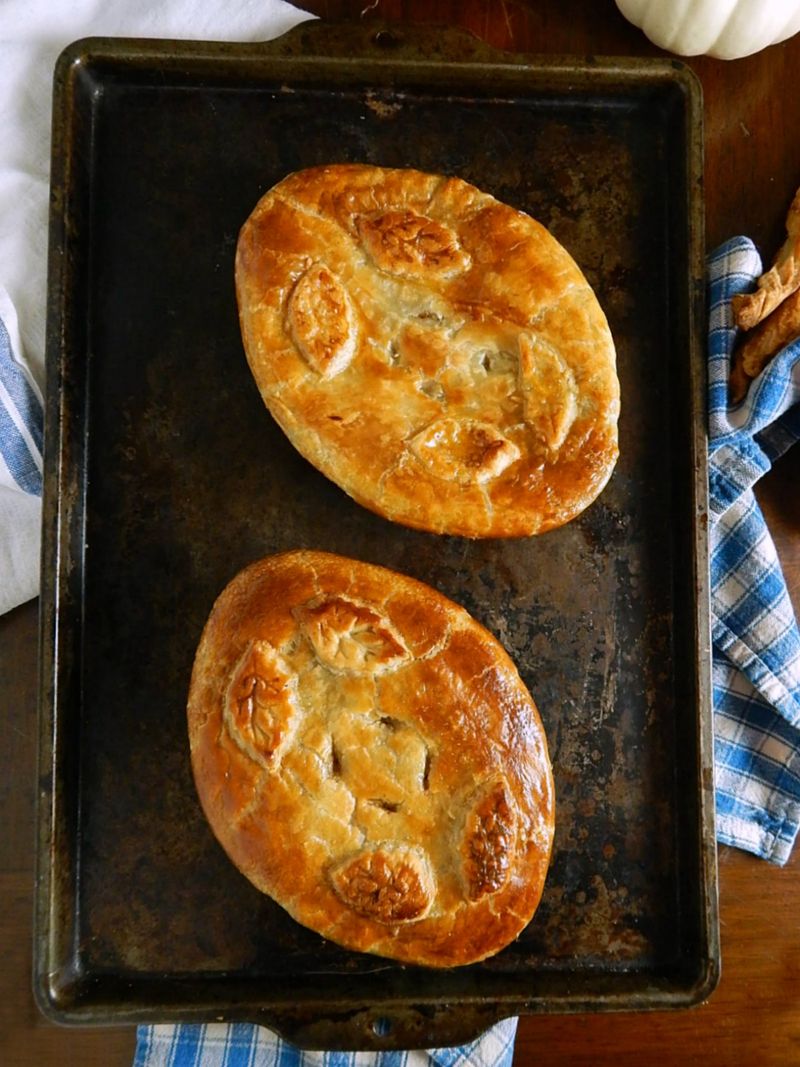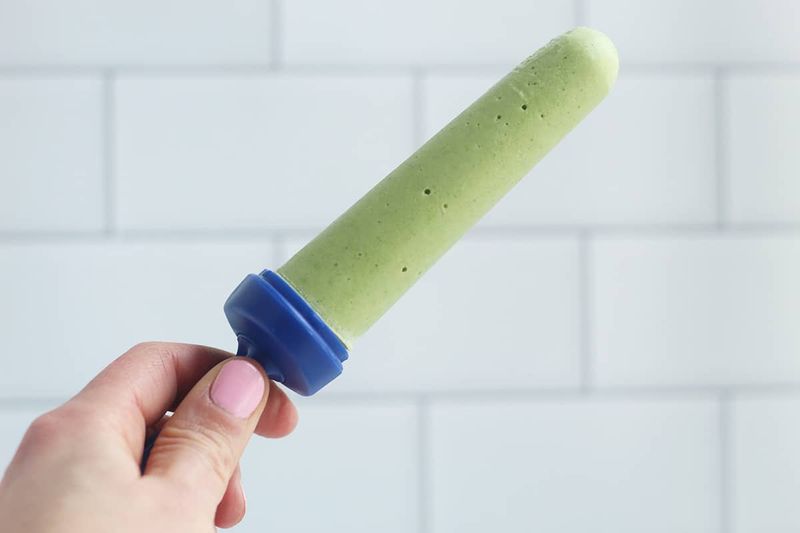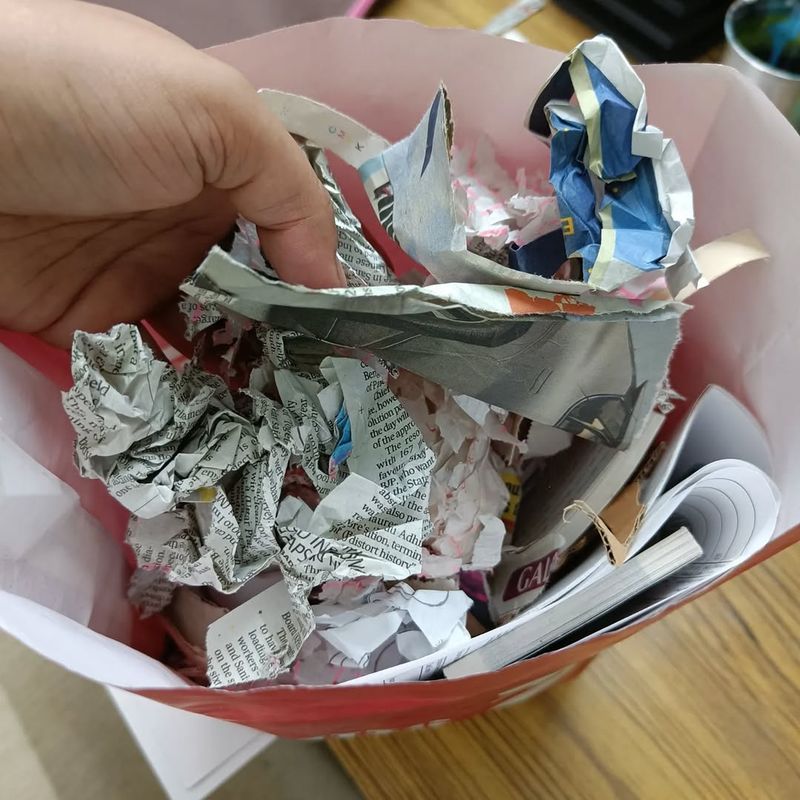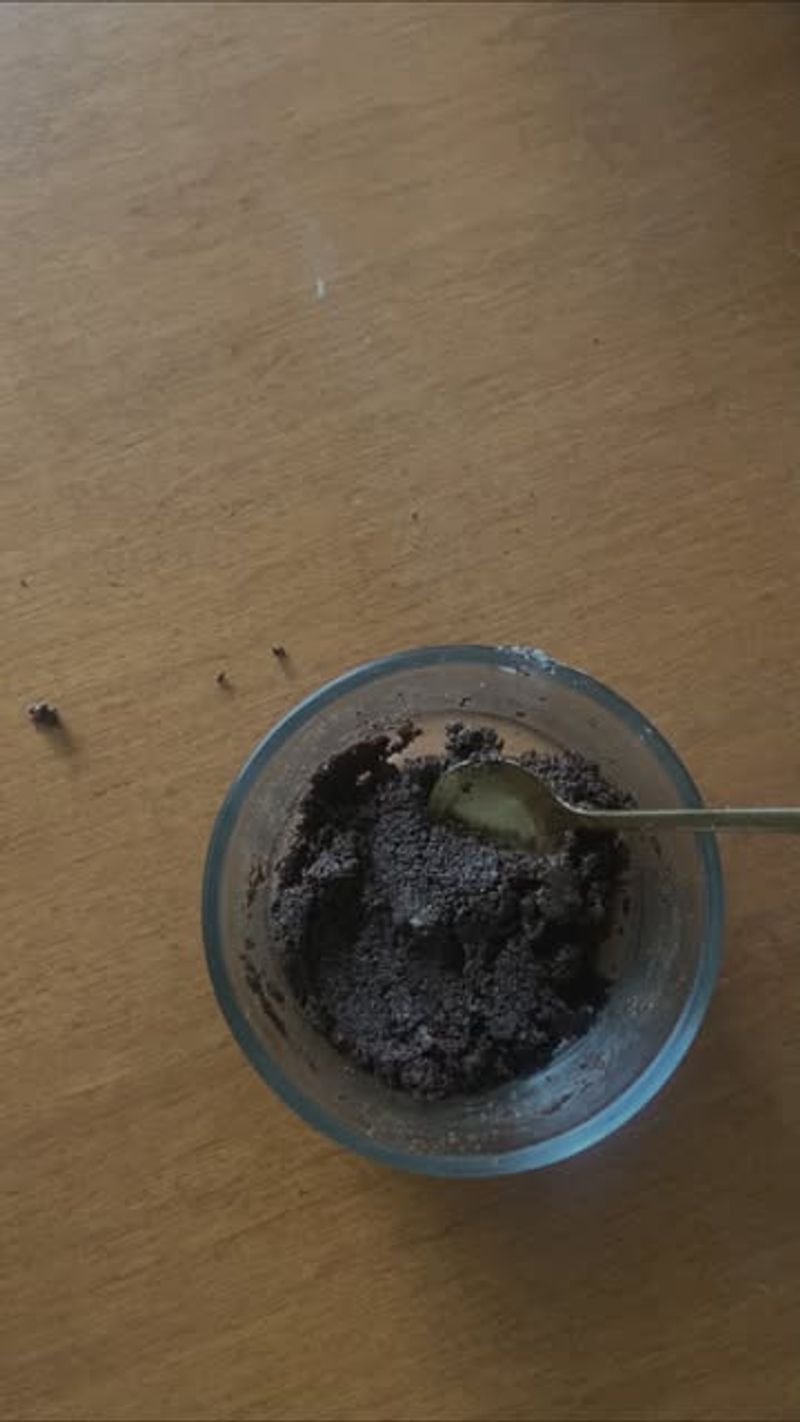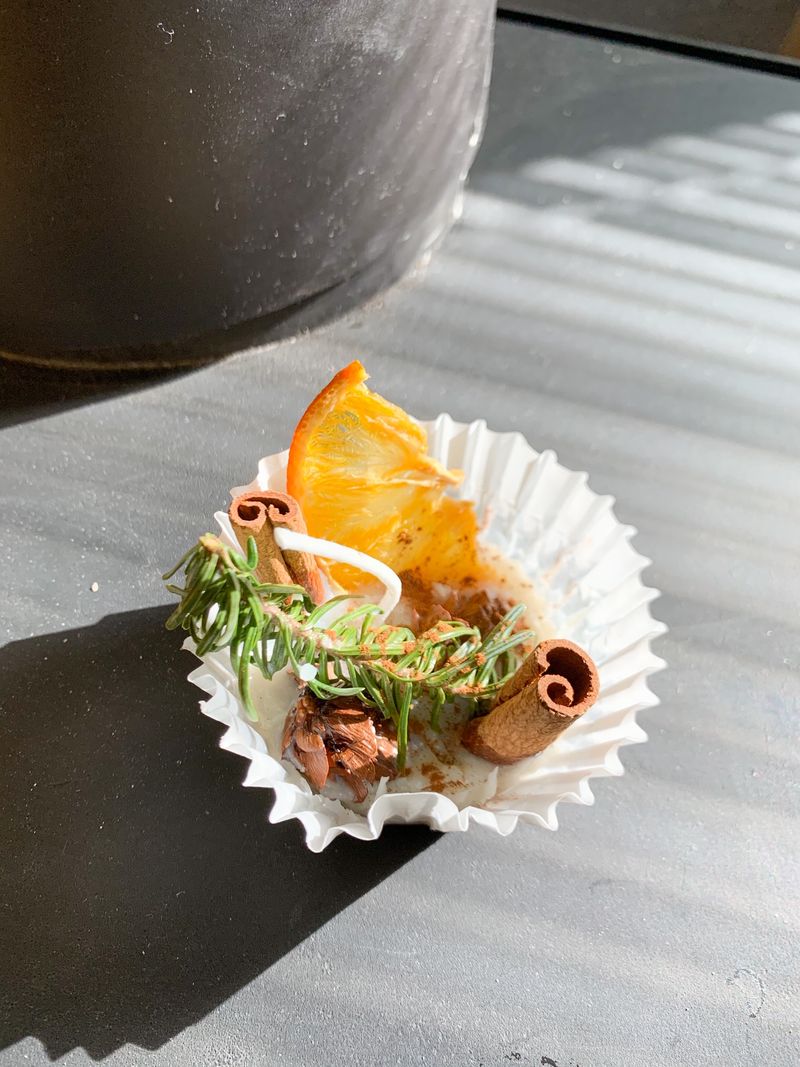Reducing waste is not just beneficial for the environment. It also helps in making the most of what we have left.
By using up leftovers creatively, we can cut down significantly on the food that goes to waste.
This article provides you with 35 innovative ideas to minimize waste while enjoying delicious meals. Each tip aims to inspire you to think differently about leftovers and contribute to a more sustainable lifestyle.
1. Soup From Vegetable Peelings
If you’ve ever wondered how to make the most of those vegetable peelings, consider turning them into a rich, flavorful soup. Gather the peelings from carrots, potatoes, and even onions, and let them simmer in a pot with some herbs and spices.
Wherever you have access to fresh produce, this method can be a lifesaver. In the heart of the city or the countryside, vegetable peeling soup is a versatile way to repurpose kitchen scraps. With a bit of creativity, you can even add leftover meats or grains to create a more hearty meal.
2. Bread Croutons From Stale Bread
How often do you find yourself with bread that’s past its prime? Instead of discarding it, consider making croutons. Cubes of stale bread can be seasoned with olive oil, garlic, and herbs, then baked to a crisp finish. This not only saves the bread but also enhances salads and soups with a delightful crunch.
the process is as simple as slicing and seasoning. Baking at a low temperature ensures the croutons dry out completely, preventing any mold formation. Croutons store well in airtight containers, making them a ready-to-use option for your next meal.
3. Fruit Smoothies From Overripe Bananas
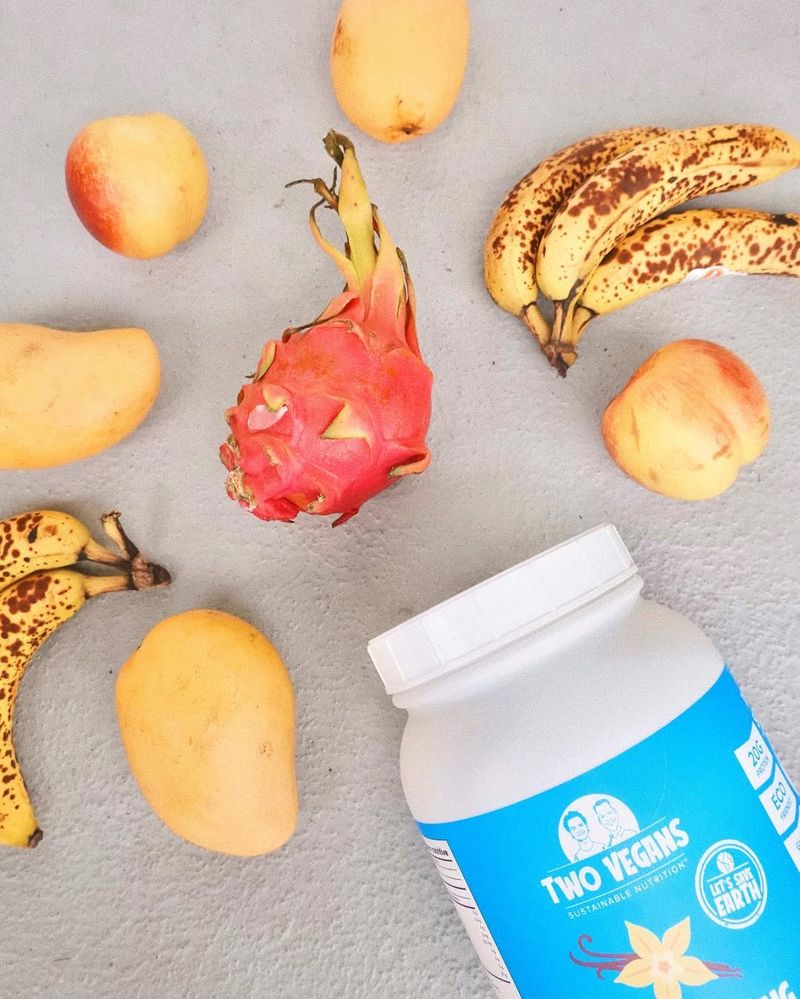
Overripe bananas are perfect for smoothies. They add natural sweetness and a creamy texture that enhances any fruit blend. Simply peel, slice, and freeze them for your next smoothie craving. Wherever you are, a smoothie can be a refreshing treat.
Blend those bananas with strawberries, spinach, or mango for a nutritious breakfast or snack. It’s quick, it’s easy, and best of all, it’s waste-free. Additionally, bananas can replace sugars and sweeteners, offering a healthier alternative. Don’t stop at smoothies. Overripe bananas are also great for baking banana bread or muffins.
4. Leftover Roast Into Sandwich Fillings
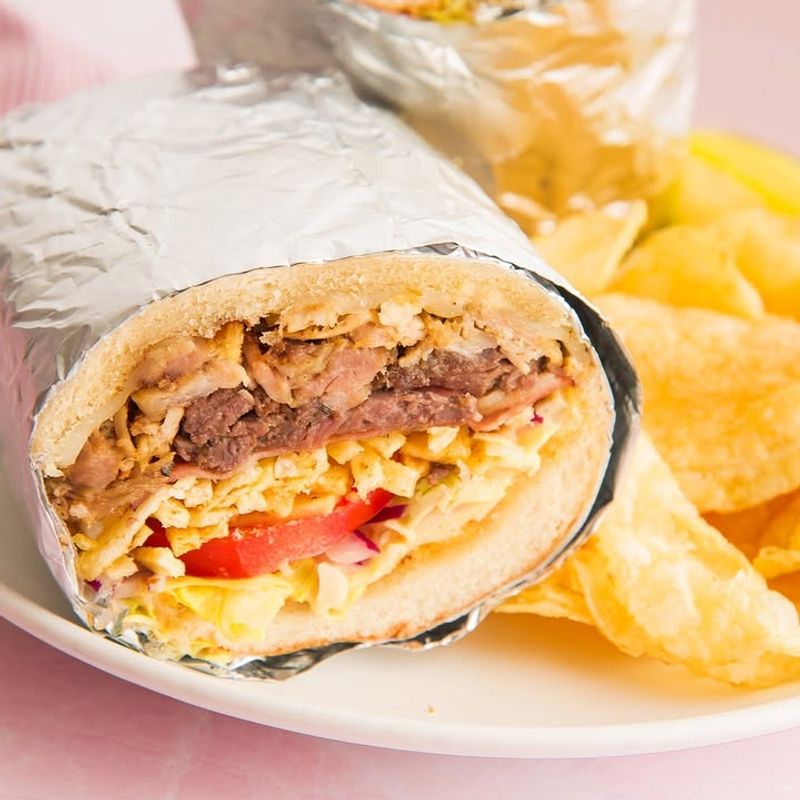
What if you could transform leftover roast into a delicious meal? Turning roast meat into sandwich fillings is a wonderful way to ensure nothing goes to waste. By slicing it thinly, you can create hearty sandwiches perfect for lunch or a light dinner. Add some fresh greens and a dollop of mustard for a satisfying bite.
Try different seasonings or sauces to switch up the flavors. This method works well with beef, pork, or chicken, providing a versatile solution for leftovers. It’s not only practical but also a delightful way to relive the flavors of your roast. Using leftovers creatively can save time and resources.
5. Herb-Infused Oils From Herb Stems
If you’ve ever discarded herb stems, it’s time to rethink. Herb-infused oils are a fantastic way to extract every bit of flavor from these often-overlooked parts. Simply immerse stems of rosemary or thyme in olive oil and let them sit to infuse. These oils can then be used in dressings, for drizzling over dishes.
Wherever you have fresh herbs, this technique can be applied. It’s a wonderful way to ensure that no part of your herbs goes unused. The aromatic oils also make great gifts, showcasing your commitment to reducing waste and maximizing flavor.
6. Vegetable Stock From Scraps
How about creating a rich vegetable stock from scraps? This is an excellent way to use up leftover vegetable pieces such as carrot tops, onion skins, and celery leaves. By simmering these scraps with water and spices, you can create a base for soups, stews, and sauces that is both flavorful and thrifty.
If you’re looking for a budget-friendly alternative in the kitchen, homemade stock is the answer. It’s as simple as letting the scraps cook slowly to extract all the essence and nutrients. The beauty of this method is that it relies on parts usually thrown away, turning them into something valuable.
7. Eggshell Fertilizer For Gardens
Where do your eggshells end up? Instead of tossing them, consider using them as a natural fertilizer. Crushed eggshells are rich in calcium and make a great addition to garden soil, helping plants grow strong and healthy.
Eggshells can be a sustainable way to enrich your soil. Simply rinse and dry the shells, then crush them into small pieces. By adding them to your garden, you not only reduce waste but also enhance the nutrient content of the soil. Each time you enjoy eggs, you’re also contributing to the health of your plants.
8. Rice Pudding From Leftover Rice
How often do you find yourself with leftover rice? Instead of discarding it, transform it into a luscious rice pudding. By cooking the rice with milk, sugar, and a dash of cinnamon, you create a comforting dessert that’s both simple and satisfying.
It’s a versatile dish that can be enjoyed warm or cold, making it perfect for any season. Additionally, you can customize it by adding raisins, nuts, or even chocolate chips for extra flavor. Though rice pudding might sound traditional, it offers endless possibilities for creativity in the kitchen.
9. Jam From Overripe Berries
If you’ve ever had berries on the brink of going bad, making jam is a perfect solution. Overripe berries are ideal for jam, as their natural sugars intensify the flavor. By simmering them with sugar and a bit of lemon, you can create a delightful spread for toast, pastries, or even yogurt.
Wherever you have access to fresh berries, this method can be a delicious way to avoid waste. Homemade jam captures the essence of seasonal fruits and can be stored for months. It’s both a satisfying weekend project and a wonderful way to preserve flavors.
10. Breadcrumbs From Leftover Bread
How about turning leftover bread into breadcrumbs? This is a simple yet effective way to ensure no loaf goes to waste. By drying and grinding the bread, you create a versatile ingredient that can be used for coating, binding, or adding texture to dishes.
If you’re aiming to minimize food waste, breadcrumbs offer a practical solution. They can be seasoned to suit different culinary needs, such as Italian herbs for pasta dishes or cinnamon for desserts. Additionally, breadcrumbs store well in airtight containers, making them a convenient pantry staple.
11. Citrus Zest For Flavor Enhancement
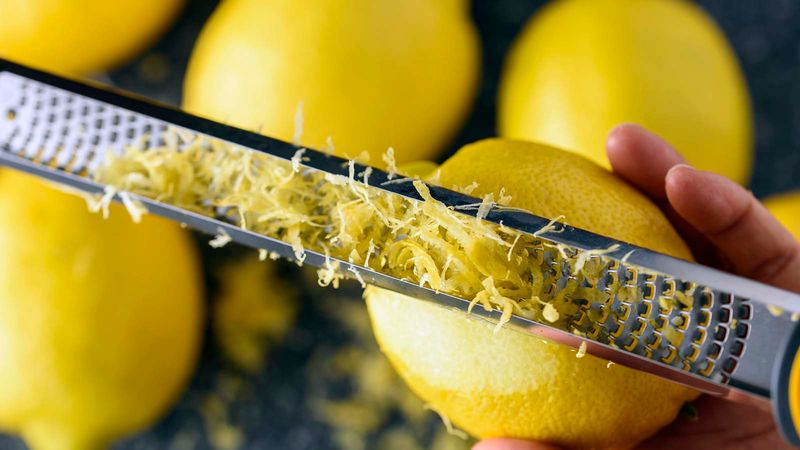
Where do those citrus peels go after juicing? Instead of discarding them, consider using the zest for flavor enhancement. Citrus zest can elevate both sweet and savory dishes with its vibrant aroma and taste. Simply grate the outer peel of oranges, lemons, or limes and sprinkle it into your recipes.
If you’re looking to add a fresh twist to your cooking, zest is a versatile option. It can enhance desserts, marinades, sauces, and even cocktails. Zest can be dried and stored for later use, ensuring that no part of the citrus fruit goes to waste.
Next time you’re about to discard those peels, think of the zestful possibilities they hold.
12. Pasta Sauce From Tomato Scraps
If you’ve ever wondered what to do with tomato scraps, consider turning them into a rich pasta sauce. By simmering the cores, skins, and seeds with herbs and garlic, you can create a delicious sauce perfect for any pasta dish.
Wherever tomatoes are in abundance, this method can be a wonderful way to reduce waste. The natural sweetness and acidity of the scraps contribute to a well-balanced sauce that captures the essence of fresh tomatoes.
13. Chili Oil From Chili Scraps
Using leftover chili stems and seeds, you can create a spicy oil that adds heat to any dish. Simply simmer the scraps in oil until the flavors infuse, then strain and store the oil.
This method is an excellent way to ensure no part of your chilis goes to waste. Chili oil can be drizzled over pizzas, pastas, or stir-fries, offering a quick and easy way to add depth to your cooking. Each drop of oil carries the fiery essence of chilis, enhancing dishes with minimal effort.
Next time you’re about to discard those scraps, think chili oil. It’s a bold and resourceful addition to your kitchen repertoire.
14. Crispy Chips From Potato Peelings

Ever peeled potatoes and wondered about the waste? Consider turning those peelings into crispy chips. By seasoning and baking them, you can create a delightful snack that’s both healthy and waste-free.
This method can be a delicious way to reduce waste. The peelings are packed with flavor and nutrients, offering a crunchy alternative to traditional snacks. The process of making chips is simple and rewarding. It’s turning something often discarded into a tasty treat.
It’s a crunchy reminder of the potential within your kitchen.
15. Herbal Tea From Herb Stems
How about brewing herbal tea from herb stems? Instead of discarding them, use the stems of herbs like mint or basil to create a refreshing tea. Simply steep the stems in hot water, and you’ll have a flavorful beverage in no time.
If you’re a tea enthusiast, this method offers a creative way to enjoy the full potential of your herbs. It’s a calming ritual that celebrates the essence of fresh ingredients, providing a warm and aromatic experience. It might seem unconventional, but using herb stems for tea is a delightful way to reduce waste.
16. Pickles From Cucumber Ends
When I cut off cucumber ends and wondered what to do, I make pickles. By soaking the ends in vinegar with spices, you can create tangy pickles that add zest to any meal. The pickling process transforms the ends into a crunchy snack or condiment that complements a variety of dishes.
However, ensure the cucumber ends are fresh and blemish-free. The art of pickling is both a practical and creative way to embrace sustainability in your kitchen. Enjoy the satisfaction of crafting homemade pickles while knowing that you’ve made the most of your produce.
17. Candy From Citrus Peels

Where do those citrus peels go after juicing? Instead of discarding them, consider turning them into candy. By simmering the peels in sugar syrup, you can create a sweet treat that’s both delightful and waste-free.
If you’re looking for a unique way to reduce waste, candied citrus peels offer a delicious solution. They can be enjoyed on their own or used to decorate desserts, adding a burst of flavor and color. Though it might seem like a small effort, making candy from citrus peels is a creative way to embrace sustainability.
18. Pasta From Leftover Vegetables
By pureeing cooked vegetables and incorporating them into pasta dough, you can create a colorful and nutritious meal. This method not only reduces waste but also adds flavor and nutrients to your pasta dishes.
If you’re a fan of homemade pasta, this technique offers a creative way to use up vegetables that might otherwise go to waste. It’s a satisfying culinary project that celebrates the versatility of fresh produce. Just make sure that the vegetables are cooked and pureed smoothly for the best results.
19. Nut Butter From Leftover Nuts

I often find myself with leftover nuts. Then, I am making nut butter. By blending nuts with a bit of oil, you can create a creamy and delicious spread that’s perfect for toast or baking. Wherever nuts are available, this method can be a tasty way to reduce waste.
Homemade nut butter captures the rich flavors of nuts and can be customized with spices or sweeteners. It’s both a satisfying and practical way to use up leftover ingredients. Each spoonful reflects a commitment to maximizing resources and minimizing waste.
20. Casserole From Leftover Meats
How often do you have leftover meats and wonder what to do with them? Instead of discarding, consider making a casserole. By combining meats with vegetables, grains, and a savory sauce, you can create a hearty dish that reinvents leftovers.
If you’re looking for a comforting meal, casseroles offer a practical way to use up various ingredients. They can be customized with different flavors and textures, providing a satisfying culinary experience. Next time you’re faced with leftover meats, remember their potential as a casserole.
21. Yogurt Cheese From Leftover Yogurt
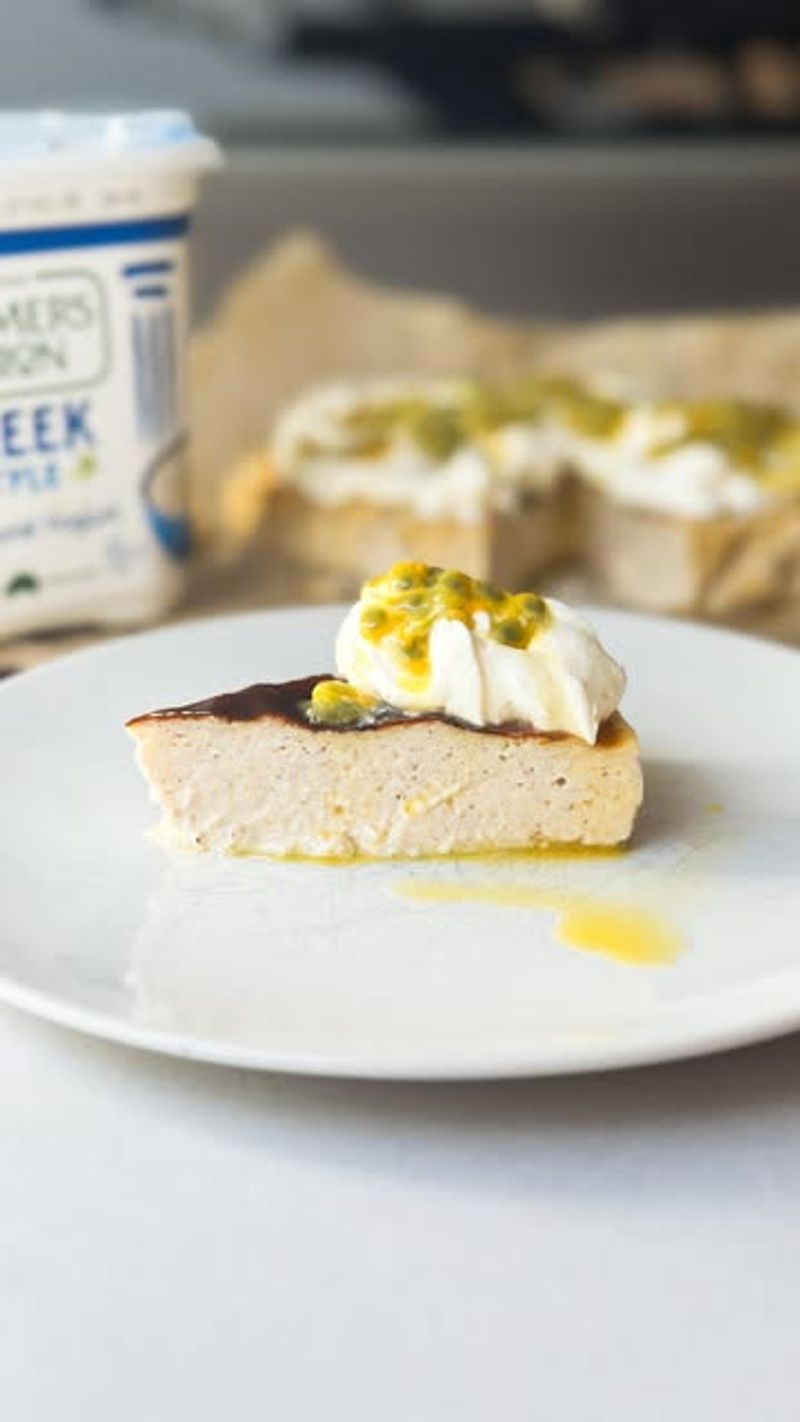
Where does leftover yogurt go in your kitchen? Instead of discarding it, consider making yogurt cheese. By straining yogurt through a cloth, you can create a creamy and tangy cheese that’s perfect for spreads or dips.
This method offers a creative way to reduce waste. Yogurt cheese is versatile and can be flavored with herbs, garlic, or spices, offering endless possibilities for culinary exploration. It’s a flavorful and resourceful choice.
22. Soup From Leftover Chicken

Making soup is a perfect solution for leftover chicken. By simmering the bones and meat with vegetables and herbs, you can create a nourishing broth that’s both comforting and waste-free. Chicken is a staple, this is a delicious way to use every part of the bird.
The rich flavors of homemade soup capture the essence of home cooking and provide warmth and sustenance. I always make sure the chicken is fresh and properly stored before use. The process of making soup from leftovers is both practical and satisfying.
23. Fruit Vinegar From Overripe Fruits
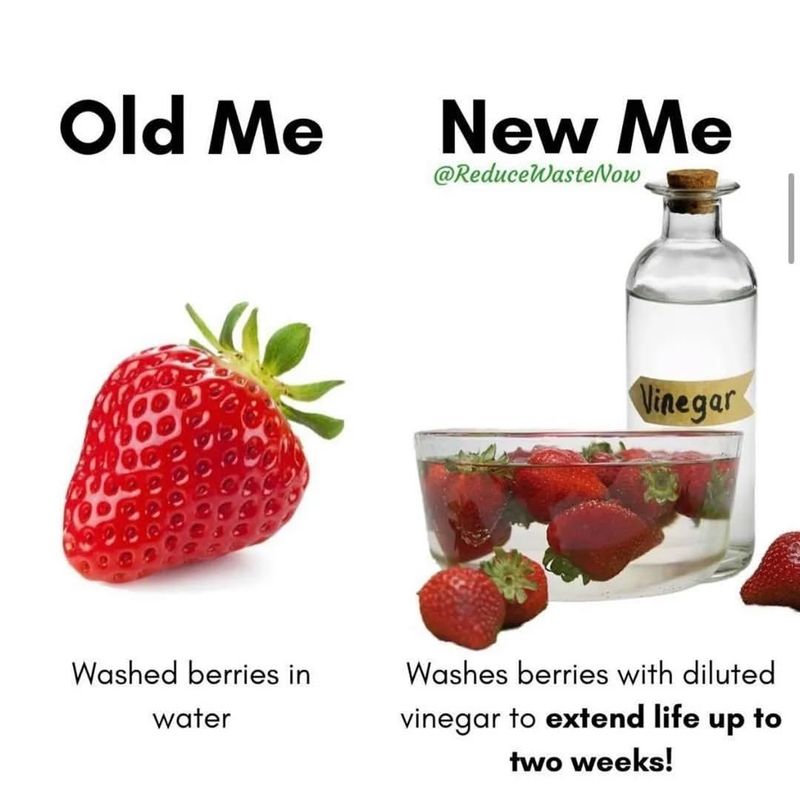
Turning overripe fruit into vinegar is a creative solution. By fermenting fruits with sugar and water, you can create a tangy vinegar that’s perfect for dressings or marinades. I feel like we are all fans of homemade condiments. This is a unique way to reduce waste.
Fruit vinegar captures the essence of ripe fruits. It adds depth to your culinary creations. It’s both a satisfying and practical project that celebrates the versatility of fresh produce.
24. Sauce From Cheese Rinds
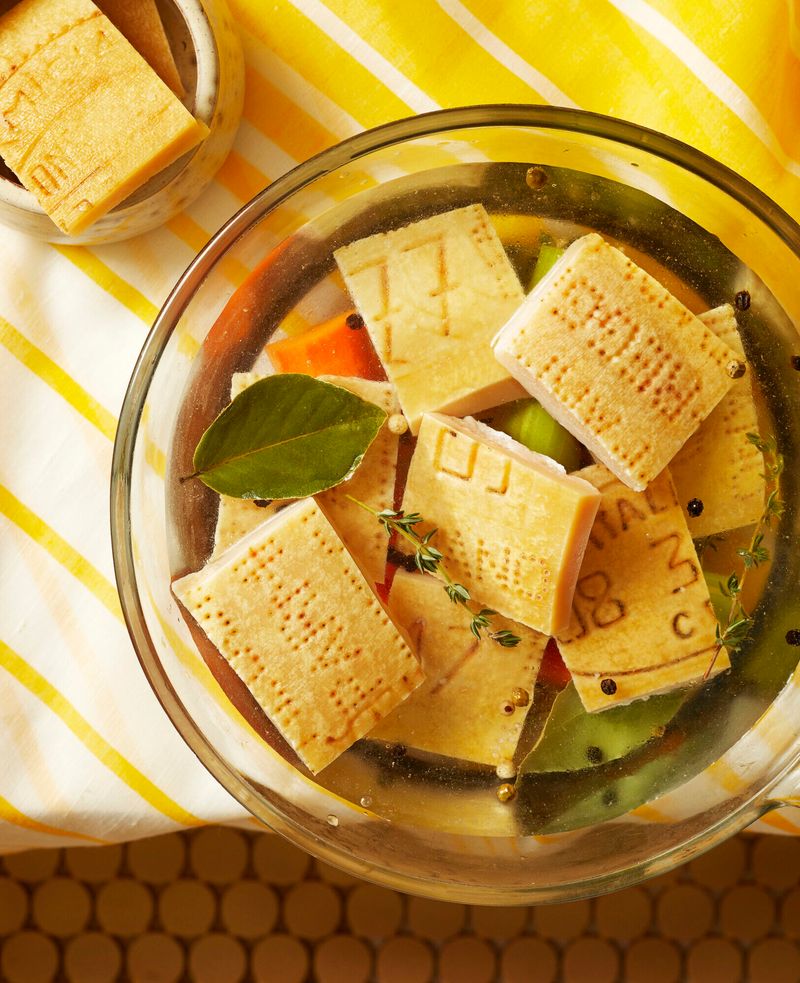
Where do the rinds of your cheese end up? Instead of tossing them, consider making a sauce. By simmering cheese rinds with cream and herbs, you can create a rich and flavorful sauce that’s perfect for pasta or vegetables.
I can’t think of more creative way to enjoy the full potential of your cheese. The creamy sauce has the essence of aged cheeses. It provides a luxurious touch to your dishes. Next time you’re about to discard cheese rinds, think of the creamy potential they hold.
25. Flavored Ice Cubes From Herb Infusions
Those wilting sprigs of herbs at the back of your fridge? Don’t toss them! Instead, give them a new lease on life by infusing them into ice cubes. Simply chop your favorite herbs like mint, basil, rosemary, or thyme, and add them to an ice cube tray.
Fill with water (filtered is preferable) and freeze. These aromatic ice cubes add a burst of fresh flavor to water, cocktails, iced tea, or even soups. Imagine a mojito with mint ice cubes or a cucumber cooler elevated with basil ice. The possibilities are endless!
26. Savory Muffins From Cheese Ends
We’ve all faced the dilemma of cheese ends, those awkward pieces that are too small to slice but too flavorful to discard. The solution? Savory muffins! Grate or crumble those leftover cheese ends – cheddar, Parmesan, Gruyere, even feta – and incorporate them into your favorite muffin recipe.
Add some chopped veggies like spinach, sun-dried tomatoes, or olives for an extra layer of flavor and texture. These savory muffins are perfect for breakfast, lunch, or a quick and satisfying snack. Not only do you reduce waste, but you also create a unique and delicious treat.
27. Cider From Apple Cores
Before tossing those apple cores after baking a pie or enjoying a fresh apple, consider making your own cider. Apple cores, along with the peels, are packed with flavor and pectin, which will help thicken your cider.
Simply simmer the cores and peels in water with a cinnamon stick and a few cloves.
Strain the mixture and add a touch of honey or maple syrup to sweeten, if desired. The result is a light, refreshing cider with a subtle apple flavor. It’s a wonderfully simple way to transform what was once considered trash into a delightful beverage.
28. Pie From Leftover Savory Fillings
How often do you have leftover savory fillings and wonder what to do with them? Instead of discarding, consider making a pie. By combining fillings with pastry, you’ll have a satisfying dish that reinvents leftovers.
Pies offer a practical way to use up various ingredients. They can be customized with different flavors and textures, providing a satisfying culinary experience. Though it might seem like a simple idea, using leftovers for pies is a delightful way to reduce waste.
29. Smoothie Popsicles From Leftover Smoothie
If you’ve ever had leftover smoothie, consider turning it into popsicles. Simply pour the smoothie into molds and freeze. That’s it! You can create a refreshing treat that’s both healthy and waste-free.
Smoothie popsicles have the essence of fresh fruits and provide a satisfying snack for any occasion. Each reflects a commitment to maximizing resources and minimizing waste. Next time you’re faced with leftover smoothie, think popsicles. It’s a refreshing and resourceful choice for any home cook.
30. Sauce From Leftover Marinades
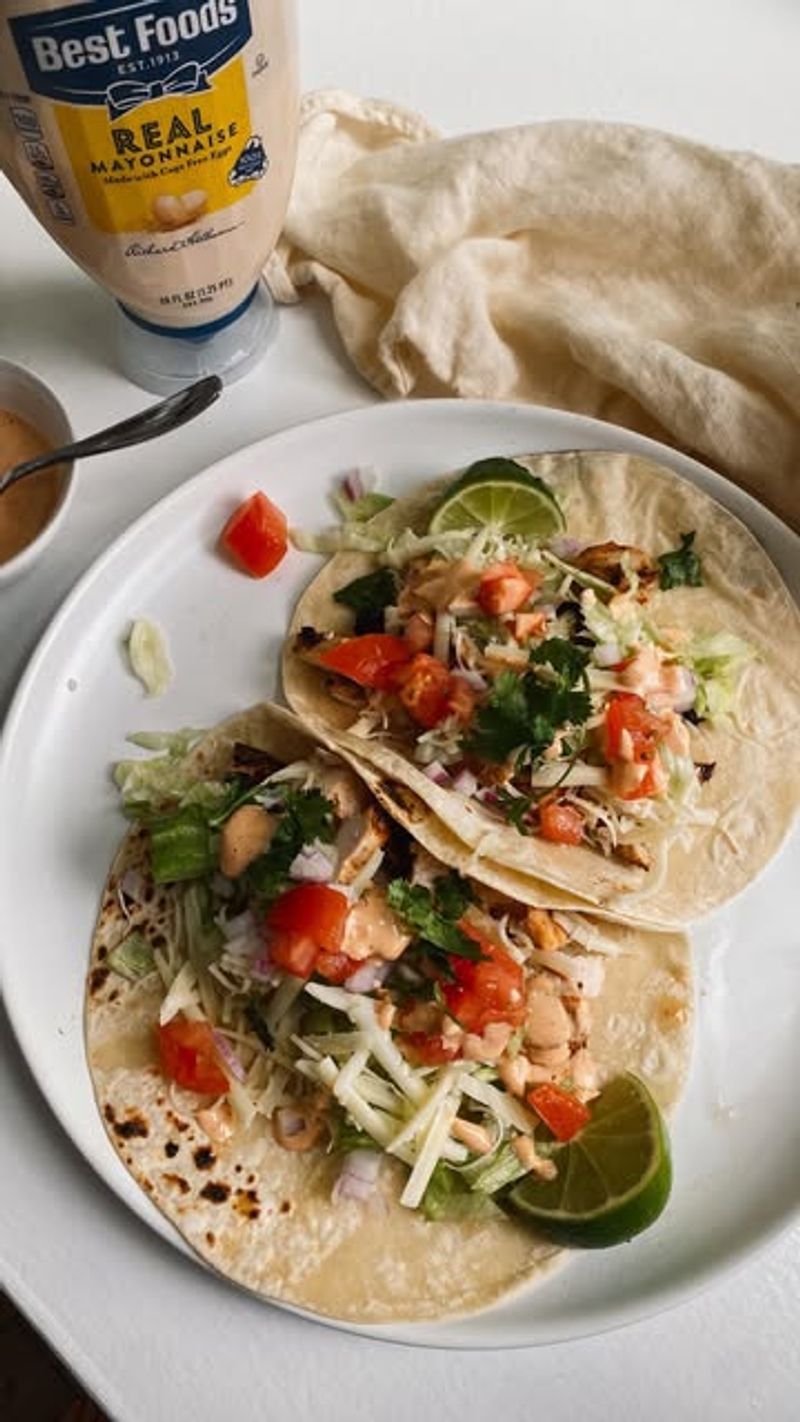
Marinating meat and vegetables is a fantastic way to infuse them with flavor, but what happens to that leftover marinade? Instead of tossing it down the drain, transform it into a delectable sauce! After cooking your marinated ingredients, carefully pour the marinade into a saucepan and bring it to a boil.
This crucial step eliminates any potential bacteria that may have been transferred from the raw food. Continue to simmer, stirring occasionally, until the marinade reduces and thickens into a flavorful sauce. You can even add a touch of honey, brown sugar, or citrus juice for added sweetness and complexity.
31. Salad Dressing From Pickle Juice
Don’t drain that pickle jar just yet! That leftover pickle juice is packed with flavorful vinegar, spices, and herbs – the perfect base for a surprisingly delicious salad dressing. Simply combine the pickle juice with a little olive oil, Dijon mustard, a touch of honey or maple syrup for sweetness.
Experiment with ratios to find your perfect balance of tangy and sweet. This quick and easy dressing adds a unique and unexpected twist to your salads, and it’s a fantastic way to reduce food waste. Beyond salad dressing, pickle juice can also be used to brine chicken or as a flavor booster in potato salad.
32. Scrambled Eggs From Leftover Egg Whites
Bakers often find themselves with a surplus of egg whites after using the yolks for recipes like custard or hollandaise sauce. Instead of letting them go to waste, whip up some light and fluffy scrambled eggs! Simply whisk the egg whites with a splash of milk or water, season with salt and pepper.
Cook them in a lightly oiled pan over medium heat, stirring frequently until set. For added flavor and texture, consider incorporating chopped vegetables like spinach or onions. These scrambled egg whites are a healthy and delicious way to start your day and a great way to utilize a common kitchen leftover
33. Recycled Paper From Scrap Paper
Beyond food waste, we can also find opportunities to upcycle everyday items like scrap paper. Transform your old newspapers, magazines, and junk mail into recycled paper for crafting, wrapping gifts, or even making seed paper to plant flowers.
There are numerous tutorials online that guide you through the process, which typically involves shredding the paper, soaking it in water, blending it into a pulp, and then pressing it into sheets to dry. This hands-on project is fun way to reduce your reliance on virgin paper products.
34. Coffee Ground Face Scrub
Coffee grounds are not just for your garden. They make an excellent exfoliant for your skin. Mix used coffee grounds with a bit of coconut oil or honey to create a nourishing face scrub. In the morning, this concoction can help wake up your skin just like your cup of joe wakes you up.
The gritty texture of coffee grounds helps remove dead skin cells, leaving your face smooth and soft. The antioxidants in coffee can also benefit your skin by providing protection against free radicals. Plus, it’s a budget-friendly and eco-friendly alternative to commercial scrubs.
35. Pasta Water Bread
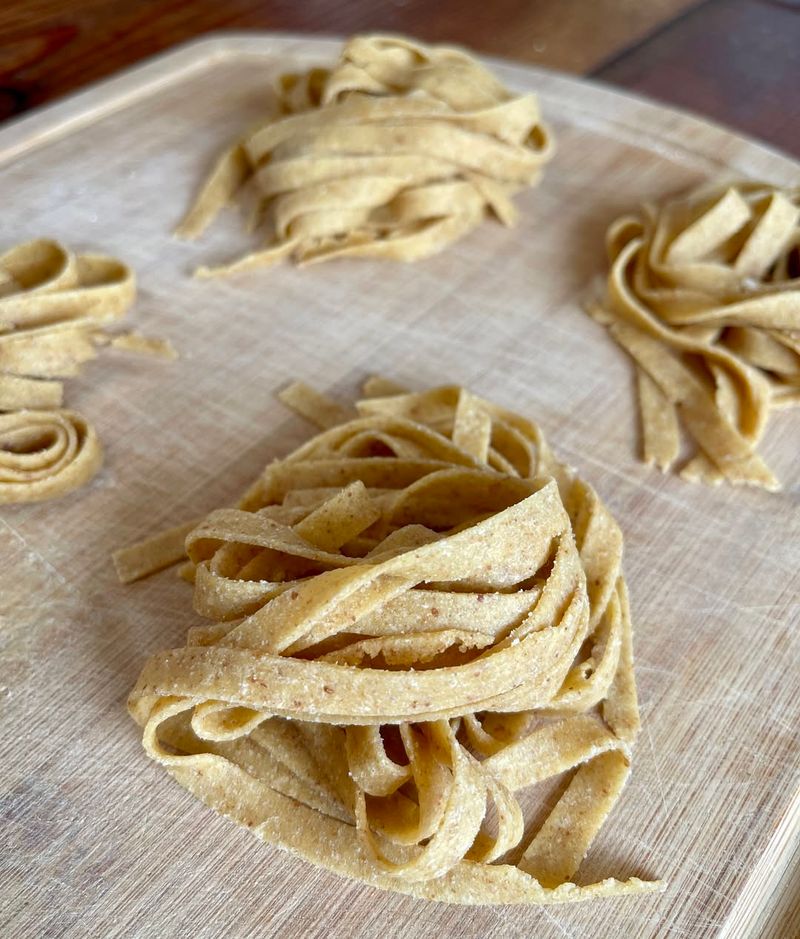
Pasta water is a hidden gem in bread-making. The starch from the pasta water adds moisture and flavor to your dough. Use it as a replacement for regular water when baking bread, and you might notice a delightful difference in texture and taste.
Not only does this practice reduce waste, but it also enhances the nutritional value of your bread with the minerals from the pasta. This unique approach adds an Italian flair to your baking routine, offering a delicious twist on traditional bread-making methods. Plus, it’s a fun experiment with tasty results.
36. Citrus Peel Fire Starters
Instead of tossing those citrus peels, transform them into fire starters. Dry the peels until they are hard and brittle. Their natural oils make them flammable, providing a quick and aromatic ignition for fires. Perfect for camping trips or cozy nights by the fireplace, these peels add a lovely citrus scent.
This creative reuse not only reduces waste but also infuses your fireside experiences with a refreshing aroma. It’s an easy and effective way to recycle kitchen scraps while adding a touch of nature’s perfume to your outdoor adventures. Embrace this green alternative to chemical fire starters.

